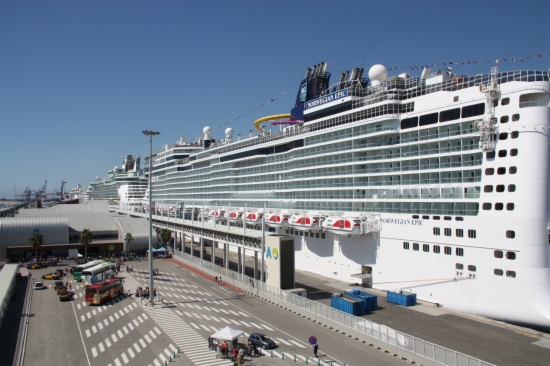Catalonia welcomed 15.6 million foreign tourists in 2013
In 2013, Catalonia was the first tourist destination in Spain. It received15.6 million foreign visitors, meaning 25.7 % of the total number of international tourists in Spain (one in four). The figure represents an 8% increase over the previous year. The Balearic Islands were in second place, welcoming over 11 million tourists (18.3%), a 7.2% increase. The Catalan Minister for Business and Employment, Felip Puig, stressed that tourist spending also increased significantly, generating €14.2 billion in 2013, that is to say 14% more than the previous year. At Spanish level, the number of foreign visitors reached a new record: Spain welcomed 60.6 million tourists in 2013, making it the third favourite travel destination in the world, behind France and the United States.

Madrid (ACN).- In 2013,one in four foreign tourists who travelled to Spain visited Catalonia, according to figures released by the Spanish Ministry of Industry, Energy and Tourism. 15,588,203 people, amounting to 25.7 % of the total number of foreign tourists, visited Catalonia, an 8% increase over the previous year. In second position stood the Balearic Islands, welcoming over 11 million tourists (18.3%), a 7.2% increase. During a press conference this Tuesday, the Catalan Minister for Business and Employment, Felip Puig, stressed that tourist spending in Catalonia had also increased significantly in 2013, generating €14.2 billion, that is to say 14% more than the previous year. In the whole of Spain, the number of foreign visitors reached a new record, registering a 5.6 % increase over the previous year. The country welcomed an unprecedented 60.6 million tourists in 2013, making it the third favourite travel destination in the world, behind France and the United States. In monthly terms, last December, Catalonia was the second most visited Autonomous Community in Spain and attracted 750,184 tourists, meaning 24.5% of the total number of visitors, and a 20.2% increase over the previous year. Catalonia was right behind the Canaries, which received 1.04 million tourists.
In a press conference this Tuesday, the Catalan Minister for Business and Employment, Felip Puig, stated that Catalonia had “established itself as a leading tourist destination in Europe” and was looking to reach higher standards at international level. With 15.6 million visitors, “Catalonia remains the top destination in Spain” he said, underlining that the increase in the number of tourists in Catalonia (8%) was higher than the increase at Spanish level (5.6%).
Felip Puig added that last year, tourist spending had generated €14.2 billion, meaning 14% more than the previous year, and a contribution of nearly 7% to Catalonia’s GDP. Puig said the Catalan authorities were hoping to further increase tourist spending in future years.
The UK, France and Germany are the main markets
In yearly terms, the United Kingdom accounted for 23.6% of the total number of visitors in Spain, thereby remaining the first source market. It was followed by Germany (16.2%), France (15.7%) and the Nordic countries (8%). Russian tourists, in spite of accounting for only 2.6% of all foreign tourists, registered the sharpest relative increase (31.6%).
At Catalan level, the highest annual increases in the number of visitors were registered by the United Kingdom and France, as well as by Russia. However, in December, the Italian market registered the most significant increase: 17.2 %, amounting to 173,717 tourists. In global terms, however, Catalonia welcomed 3.2 million Italian tourists throughout the year, representing an 8.1 % decrease.
Madrid is the only area which registered a drop in tourist numbers
In the Balearic Islands, the number of foreign visitors exceeded 11 million, representing a 7.2% increase over 2012. The Autonomous Community of Valencia received 5,971,523 people, representing 9.8% of the total number of visitors and an 11.4% increase compared to last year. Madrid, while remaining one of the main tourist destinations in Spain, is the only Autonomous Community that registered a drop in its number of visitors: the 4.2 million tourists it welcomed in 2013 represent a 5.3 % decrease over the previous year.
Spain welcomes 60.6 million foreign tourists, a historic record
For the first time ever, Spain has passed the 60 million tourists mark, a “historic” figure, according to the Ministry of Industry, Energy and Tourism. Indeed, in 2013, the country was the third favourite travel destination in the world, behind France and the United States. The increase in the number of foreign visitors registered in Spain in 2013 is also higher than the worldwide figure, set around 5%. In December, Spain received 3.1 million international tourists, representing a 16.3 % increase over the same month last year.
Opposite trend for Catalan and Spanish tourists
While the number of foreign visitors in Spain has increased considerably, Catalan and Spanish tourists are less and less numerous, due to the economic crisis. In this regard, Puig argued that the 8.4% decrease of Spanish tourists in Catalonia had nothing to do with the Catalan independence claims: “We see that there are, in some cases, very similar trends” among different Autonomous Communities. “Madrid has an 8.1 % drop [of Spanish tourists], and they have no self-determination process” going on said Puig. He also added that Asturias, Murcia, Galicia or the Canaries had also registered decreases.
2.6 million cruise ship passengers in Barcelona
Finally, Puig praised the positive figures of Barcelona’s Port, which increased its number of cruise ship passengers by 7.9% over the previous year. 2.6 million visitors passed through the Catalan capital on a cruise ship. Puig also highlighted that this type of tourism was gradually becoming less attached to the high season and that it now spanned the entire year. The Catalan Minister pointed out that the cruise industry can still grow in Catalonia.